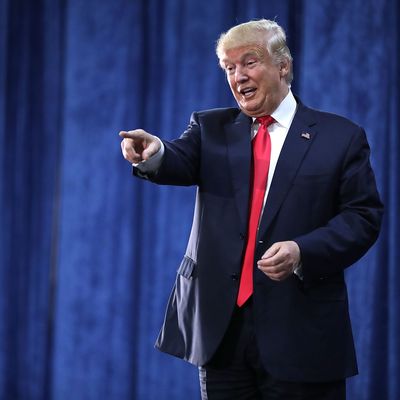
Donald Trump’s election will be a great boon to global economic stability. Or so a new report from the Organization for Economic Cooperation and Development would seem to suggest.
In its biannual assessment of global economic prospects, the OECD predicts that the president-elect’s domestic agenda will push U.S. economic growth next year to 2.3 percent, up from a pre-election estimate of 1.9 percent. The following year, the organization predicts our economy’s growth rate will hit 3 percent, instead of the piddling 2.2 percent it was previously headed for — a spike that would increase Americans’ demand for foreign imports, and thus, increase global growth from 3.3 percent to 3.6 percent in 2018.
If you cock your head and close one eye, it’s easy to see why the OECD would take such an optimistic view of Trump’s agenda. As aggressive monetary policy has proven itself incapable of reviving robust growth and inflation in the world economy, there’s a growing technocratic consensus that national governments should pursue good old-fashioned Keynesian fiscal stimulus.
And America’s president-elect has promised a series of policies that would amount to just that — an enormous increase in infrastructure spending, a large supply-side tax cut, and new investments in defense and border security.
“There’s now some prospect of the world exiting from this low-growth trap,” Ángel Gurria, the OECD’s secretary-general told The Wall Street Journal this week, referring to his hopes for President Trump. “Even though we still show the signs of those very heavy legacies of the crisis, we may be at a moment where we could see a turn for the better.”
But to glimpse that turn for the better, the OECD makes a series of assumptions so baseless and wishful, its report appears to be less of an attempt to predict the effect of Trump’s actions, than it is a bid to shape those actions through suggestion and flattery.
For starters, there are many aspects of Trump’s noneconomic agenda that could nonetheless influence economic growth — the mass deportation of a key part of America’s labor force would surely have some effect on the macroeconomic climate, to name just one example.
But the OECD brackets far more than peripheral concerns about Trump’s immigration policy, kleptocratic tendencies, or seething hostility to basic civil liberties: The organization’s report assumes that the president-elect will abandon the “protectionism and the threat of trade retaliation” that he campaigned on, once he realizes that such policies would be an impediment to global growth. Instead, the OECD predicts that Trump will inform his Rust Belt base that their lost manufacturing jobs belonged to an “old economy” that isn’t coming back — but that they need not worry, because the Republican Congress will provide them with socialized child care and job retraining, as they prepare themselves for positions “at the global productivity frontier.”
The boost to [U.S.] spending on infrastructure and other investments (such as improving skills and facilitating job-finding success through more active labour market policies and the provision of child care) will combat inequality and counter the steady decline in labour force participation rates, both by prime-age men and women.
The report also assumes that Trump’s infrastructure program will not merely be a tax giveaway to the bankrollers of previously planned development projects — which is, essentially, what the president-elect’s current plan amounts to. What’s more, in addition to financing child-care subsidies, the report expects Paul Ryan’s caucus will allow the United States to run large deficits in the next two years, without drastically cutting social spending.
In light of all this, MarketWatch’s Brett Arends concludes, “The OECD’s cheerful prediction is based on the hope that Donald Trump will be an internationalist, a technocrat, and a Keynesian.” But this understates the scale of the OECD’s optimism — its projections also assume that a majority of Republican lawmakers will decide to join their president in governing as center-left Democrats.
None of this is to say that Trump’s victory will not bring about some short-term increase in economic growth. After all, for the first time in eight years, congressional Republicans actually have an incentive to improve the economy, rather than to sabotage it. This could, ostensibly, make them overcome their allergy to some version of the infrastructure spending plan that President Obama has been trying to pass for several years.
Further, based on his administration’s early embrace of the financial elite, it seems entirely possible that Trump will abandon the riskier elements of his anti-trade populism and overwhelmingly likely that he will pass a large supply-side tax cut. Together, these policies should have some stimulative effect.
Nonetheless, when reviewing the OECD’s projections, it’s important to remember that the organization is planning for the President Trump it wants, not for the one we’re stuck with.






























